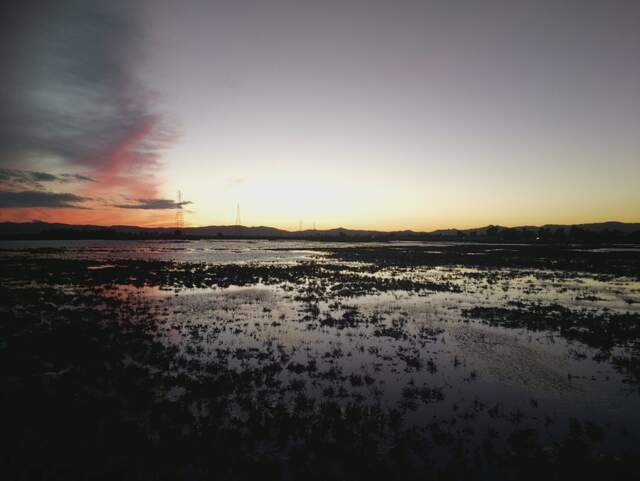Field Notes
<--2022-11-17 09:35:00 | 2022-12-21 09:30:00-->Other sites visited today: Bouldin Corn | Bouldin Alfalfa
Phenocam link: Searching...
Hill Slough: 2022-11-30 09:50:00 (DOY 334)
Author: Daphne Szutu
Others: Joe
Summary: Regular data collection/cleaning, swapped tower batteries, calibrated 7700, swapped 7500 for calibration
| 2022-11-30 Hill Slough Joe and I arrived at 9:50 PST. It was cool and sunny and relatively calm with a few thin clouds. It was near high tide and the staff gauge read 5.40ft at 10:48 PST. We don’t see any live vegetation in our footprint, but plenty of birds around. There were two female grackles on our rad boom when we arrived. As I was unloading the truck, some sort of law enforcement officer stopped by to see what we were up to. He had an official-looking truck with “warden” on it, but I didn’t catch which agency he was from. A regular citizen (with camera in hand) also parked his car by us and wanted to go out on the boardwalk. Besides regular data collection, our big tasks for today were calibrating the 7700 and swapping tower batteries. We meant to add a second staff gauge today to the channel, but our spare gauge in the lab is metric and the gauge on the boardwalk is in 0.1in. We’ll order another gauge in 0.1in units for consistency and easier gauge reading. Joe started with swapping the tower batteries. The water level was about knee high, high enough that he could more or less float the batteries in a grey plastic bin between the boardwalk and the solar panel enclosure. We brought the old batteries back to the lab The current battery bank sn BB-HS are older, flooded deep cycle batteries from EP, then SW Temp Tower, then HS. I had removed 2 bad batteries in July, so the tower is only running on 3 batteries currently. Joe turned off the tower power and removed the 3 old batteries and installed 4 new-ish Duracell flooded, deep cycle batteries with 04/22 tags. We purchased these batteries to run the BA advection experiment this summer from April through October, sn BB-BA-edge and sn BB-BA-bncr. Initially, the solar panels were not charging (0.0A on the charge controller). Cycling the solar breaker seemed to fix the issue: solar panels were producing 18A and the batteries were at 12.8V. The water level in the batteries looked ok—they should be checked again in late spring. Joe sprayed with terminals with battery terminal spray and washed the solar panels, which had some bird poop. After Joe turned the power back on, we continued with our regular tasks and the 7700 calibration. I downloaded met, cam, and USB GHG data and cleaned flux and rad sensors. The wash reservoir was full so we did not need to top it off. We calibrated the LI-7700 sn TG1-0211 as part of its routine maintenance. Luckily today was not too windy, just barely breezy. The calibration offsets were both small. This 7700 still has a thermocouple with a missing o-ring that was replaced with duct putty. Today we replaced it with a brand-new thermocouple assembly with an o-ring. The optics RH was 26%, so we also flushed the headspace with zero after calibration and swapped in fresh desiccant. We dropped the tiny desiccant screw into the water (the one that secures the desiccant plug to the sensor). The 7700 hat and spray head were placed back on the 7700 after the calibration. The 7700 software kept crashing and taking up all of the laptop’s memory. Restarting the laptop twice helped. We swapped the 7500 for calibration: sn 75H-2176 came off and sn 0042 went on. Joe uploaded a new config file, updated the pressure coefficients, and we reset the box after we finished the 7700 calibration. All looked well. I peeked into the precip bucket and the funnel looked clear. I collected a water sample from the sipper under the tower to measure for porewater conductivity back in the lab. Sample, temperature-compensated conductivity, temperature, notes Porewater, 19.52 mS,, Sample stored in fridge before being measured 11:10 PST I meant to add a larger lithium power pack to the channel since the EXO power was dropping <10V on low-light days. The current lithium battery has 12V in/out for the solar panel in and datalogger out. The new one I brought today had 24V in/out and 12V out. I needed 12V in for the solar panel, and we didn’t have a DC-DC boost converter, so we couldn’t swap lithium batteries today. 2176 dirty read: 446ppm CO2, 383mmol/m3 H2O, 9.47C, 101.8kPa, 100SS 2176 clean read: 441ppm CO2, 377mmol/m3 H2O, 9.53C, 101.8kPa, 101.8SS 0042 fresh read: 441ppm CO2, 359mmol/m3 H2O, 9.98C, 101.8kPa, 99.1SS TG1-0211 dirty read: 2.1ppm CH4, 38RSSI TG1-0211 clean read: 2.1ppm CH4, 71RSSI TG1-0211 after cal read: 2.1ppm CH4, 70RSSI We left at 11:45 PST. |
1 photos found

HS_picam_20221201_1715.jpg ( 2022-12-01 17:15:06 ) Full size: 1917x1440
Beautiful sunset at low tide
4 sets found
21 HS_met graphs found
4 HS_flux graphs found
1 HS_cam graphs found
Can't check HS_Processed
2 HS_Processed graphs found

